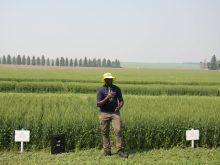Canada’s agriculture sector has come up with what it calls an achievable fertilizer emissions reduction target that is about half of what the federal government is seeking.
Fertilizer Canada and the Canola Council of Canada sponsored a study showing that a 14 percent reduction in greenhouse gas emissions by 2030 can be achieved without jeopardizing food production.
“With this report we now have a better picture of what is possible and we look forward to working in partnership with the federal government towards an ambitious but realistic emission reduction target,” said Fertilizer Canada president Karen Proud.
Read Also

New coal mine proposal met with old concerns
A smaller version of the previously rejected Grassy Mountain coal mine project in Crowsnest Pass is back on the table, and the Livingstone Landowners Group continues to voice concerns about the environmental risks.
Canola council president Jim Everson said there is no one-size-fits-all approach to reducing fertilizer emissions and it must be balanced with farm productivity.
“This report helps underscore the need to work collaboratively with farmers and industry across regions to ensure farmers have the flexibility and support to use the practices that are best suited to their farms,” he said in a news release.
Brandon Leslie, manager of policy and government relations with Grain Growers of Canada, welcomed the findings of the study.
“The report does a pretty good job of highlighting the fact that a 30 percent reduction isn’t really feasible within the government timeline, particularly if we intend on increasing yields,” he said.
The study’s 14 percent reduction target falls well short of Ottawa’s self-acknowledged “ambitious” nitrogen fertilizer emissions target of 8.3 million tonnes of carbon dioxide equivalent in 2030, down from 11.8 million tonnes in 2020.
“I welcome the findings of the Fertilizer Canada report that nearly half of this (emissions reduction) target can be achieved without reducing yields with greater adoption of the 4R Nutrient Stewardship program,” federal agriculture minister Marie-Claude Bibeau said in an email statement.
But she noted that this is just one initiative and there are many other ways to meet the government’s target.
Other ideas include using non-synthetic fertilizers such as manure, composts, digestates and biosolids; the use of cover crops and intercropping; further reducing tillage; and diversifying rotations to include legumes that don’t require nitrogen fertilizer.
In addition, the government is exploring the potential of using emerging technologies like biofertilizers, nanotechnology, gene-editing and other innovations.
Proud said there are three levels of fertilizer best management practices — basic, intermediary and advanced.
To achieve the 14 percent reduction target there would have to be much wider adoption of the advanced practices.
Today’s uptake is 10 to 15 percent in Ontario and Quebec and 10 to 25 percent in the Prairies. That would have to increase to 26 to 45 percent in the east and 28 to 50 percent in the west.
Proud said the federal government seems intent on having the debate revolve around absolute emission reduction goals but that doesn’t sit well with farmers and industry.
“Instead of maybe focusing on a specific target, let’s just focus on rolling up our sleeves and seeing how far we can go with the 4R program,” she said.
The industry came up with its own absolute emissions reduction number because that is the language Ottawa wants to speak but Fertilizer Canada and many farm groups would prefer the conversation revolved around emissions intensity reduction.
They want to approach the problem from the standpoint of reducing the amount of emissions per bushel of crop produced rather than an absolute emissions reduction, which could result in less overall fertilizer applied each year.
The study concluded that it would cost farmers an estimated $495 million per year to implement the necessary level of 4R BMPs.
On an individual farm basis, the costs would start at $34 per acre in 2022 and climb to $43 per acre by 2030. That would represent between seven and 10 percent of a farm’s total operating costs.
Leslie said there is a “hefty price” to changing practices. The government would need to create new incentives or expand on existing ones like the $200 million On-Farm Climate Action Fund.
Proud said Ottawa must, as a first step, embrace the 4R program as the primary vehicle for achieving its emissions reduction goals.


















